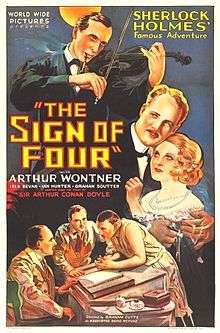The Sign of Four (1932 film)
| The Sign of Four: Sherlock Holmes' Greatest Case | |
|---|---|
 | |
| Directed by | Graham Cutts |
| Produced by | Basil Dean |
| Written by |
Novel: Arthur Conan Doyle Screenplay: W. P. Lipscomb |
| Starring |
Arthur Wontner Ian Hunter Isla Bevan |
| Music by | Ernest Irving |
| Cinematography |
Robert De Grasse Robert Martin |
| Edited by | Otto Ludwig |
Production company | |
| Distributed by | RKO Pictures |
Release dates | May 1932 |
Running time | 75 minutes |
| Country | United Kingdom |
| Language | English |
The Sign of Four is a 1932 British crime film directed by Graham Cutts and starring Arthur Wontner, Ian Hunter and Graham Soutten. The film is based on Arthur Conan Doyle's second Sherlock Holmes story The Sign of the Four and was made at Ealing Studios.
The film is also known as The Sign of Four: Sherlock Holmes' Greatest Case.
A young woman needs Sherlock Holmes for protection when she's tormented by an escaped killer. However, when the woman is abducted, Holmes and Watson must infiltrate the city's criminal underworld to track down the young woman.
Plot
Jonathan Small, a prisoner serving a lengthy sentence on the Andaman Islands cuts a deal with two army officers, Major Sholto and Captain Morstan, in command of the prison. He reveals the location of a stash of loot in exchange for their help in helping him to escape from jail. The proceeds are to be split equally between the three of them.
Sholto and Morstan go to investigate the treasure which is hidden in an old Indian fortress. When they unearth the valuable trinkets behind a brick wall it sparks a violent quarrel between the two men with each wanting to take all of the treasure. After a struggle Sholto kills his accomplice and returns to England without fulfilling his pledge to help Small escape.
A number of years later Sholto is now living in London in great wealth thanks to his theft of the treasure. However, he is disturbed to read of the escape from jail of Small. He becomes haunted by the sound of Small's wooden leg and is convinced he will shortly be killed in revenge for his past betrayal of the convict. He calls his sons Bartholomew and Theodore to him and tells them of his murky past that had gained him the wealth on which the family fortune is built. He reveals that Morstan had a daughter, Mary, and instructs his sons to send her a valuable necklace and split their inheritance with her. Shortly afterwards Sholto is murdered before he can reveal the location of the bulk of his treasure.
The killing has been committed by Small who has broken out of jail with two accomplices, a heavily-tattooed convict and a native named Tonga. He reveals himself and menaces Theodore into telling him about Miss Morstan. The gang soon begin threatening Miss Morstan in the hope that she will hand over her share of the treasure to them. Frightened, she calls in Sherlock Holmes to help her protect herself. She is approached by Theodore, who reveals that the secret hiding place of the treasure has been discovered, and offers her the share as instructed by his father, and takes them to the family house.
However, when they arrive there Bartholomew is dead, and the treasure is missing. Holmes has his theory about the murder, but the innocent Theodore is arrested for murder by the complacent detective from Scotland Yard. Holmes and Watson set out to prove Theodore's innocence and track down the gang who are threatening Miss Morstan. They soon discover that Small and his accomplices are waiting to take the necklace from Mary Morstan to complete their haul and then flee the country and are hiding out in a circus. Watson unwisely takes Mary to investigate, and she is forcibly taken by them. Small's gang plan to make their escape by boat up the River Thames, but they are pursued by Holmes and Watson. The film climaxes in a shoot-out at a deserted warehouse.
Differences from novel
The film has Sholto and Morstan together recovering the Agra Treasure in the old fort; and then has Sholto murdering Morstan. "The Tattoed Man" does not appear in the novel. The book is set in 1887 whereas the film, like all the films featuring Wontner as Holmes, is set in the 1930s.
Cast
- Arthur Wontner as Sherlock Holmes
- Isla Bevan as Mary Morstan
- Ian Hunter as Dr. John H. Watson
- Graham Soutten as Jonathan Small
- Miles Malleson as Thaddeus Sholto
- Herbert Lomas as Major John Sholto
- Gilbert Davis as Det. Insp. Atherly Jones
- Margaret Yarde as Mrs. Smith
- Roy Emerton as The Tattoed Man
- Charles Farrell as Funfair Patron
- Clare Greet as Mrs Hudson
- Moore Marriott as Mordecai Smith
- Edgar Norfolk as Captain Morstan
- Kynaston Reeves as Bartholomew Sholto
- Ernest Sefton as Barrett
- Mr. Burnhett as Tattoo Artist
- Togo as Tonga
Bibliography
- Low, Rachael. Filmmaking in 1930s Britain. George Allen & Unwin, 1985.
- Perry, George. Forever Ealing. Pavilion Books, 1994.
External links
- The Sign of Four at the Internet Movie Database
- The Sign of Four is available for free download at the Internet Archive